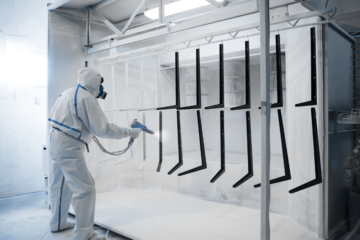
Trixware Technologies Thriving with Lean Startup Tools and Techniques
Introduction
Prod-Ezy, a flagship product of Trixware Technologies in Industry 4.0 is backed by decades of experience of Engineering SMEs and IT industry. It is an easy tool to help you make informed decisions based on accurate and real-time data from your shop-floor. It not only helps you track and monitor your shop-floor in a smarter way, but also connects your suppliers and customers intelligently to ensure end-to-end visibility.
Based on the principles of Lean Manufacturing, Prod-Ezy complies the worldwide recognized ISO Standards. We had this concept in mind and a few assumptions for it. Prod-Ezy started with just a concept, not even on paper or no MVP initially to demonstrate.
This concept is neither a disruptive innovation nor a new one in its segment. There are similar solutions available but are in bits and pieces. Also, our target customer segment was fixed initially.
Being an agile consultant and having worked with various organizations, it was clear that customer development and product development go hand in hand. Challenge was how to fit in a pirate metrics to track this as the solution which we were proposing was a desktop based product. Since there was no presence on the web, it was difficult for us to measure AARRR parameters.
This case study is to summarize how Lean Startup tools and techniques used in combination with other techniques like Steve Blank’s Customer Development Model, Value Proposition Design and Business Model Canvas by Alexander Osterwalder helped us steer our startup in right direction. Roughly divided in two sections, Customer Development and Product Development, this document will give you a fare idea of how powerful the combination of above mentioned tools and techniques would be.

Customer Development – Getting out of the building

The first obvious step was to have our hypotheses validated. We started interviewing potential users of this solution. We targeted multiple organizations and users at various levels in an organization to understand the paint areas. Though we tried to have interactive discussions the approach we roughly divided as SPIN. It really helped us in validating and strengthening our hypotheses. There were no slides used for explaining our concept but rather our MVP till this stage was just the user interaction – explaining our concept and getting valuable inputs from users.
Almost 8 to 10 weeks interacting with over 20 potential users multiple times we could figure out the exact pain areas and the pain relievers.
Meanwhile, our AARRR metrics also took shape. After interacting with users we came to know how users would like us to have a life cycle for this product and customer acquisition. Our AARRR looks like –

The main concern was customer acquisition and activation. This was one area where we were failing. Till now, we were not able to have a customer which is ready to pay us for this concept. It was now high time for us to start developing the actual product. Redefining the MVP, we identified the bare minimum capabilities and features we could develop to get the further inputs from users and our actual development started. Now as something was visible on the screen, users also started showing more interest in giving us the inputs. “I will know it when I will see it” helped us further in getting more validated learning. Our value proposition was changing and becoming better and better day by day but we were still not doing well on our AARRR metrics. It was something like this –

Acquisition and Activation rates were almost the same but no progress on any of R parameters. Users were still not seeing that much value in our concept as till this time we reached to a stage where in we were just automating their manual efforts. So it was again the time revisit our value proposition. We were still not close to the exact pain areas. Visiting a world’s one of the biggest expo for such solutions we interacted with few more users over there and then the “ah-haa” moment came in. Our users were looking for the information from our solution which will save their time in making some informed decisions and will really impact their bottom line. With this new direction now it was time for us to identify the Gain Creators for users. With some of the identified gain creators now we could see some improvement in our AARRR –

A drastic change in acquisition and activation and even referral as well! But no progress on retention and the most important parameter – Revenue.
Initially we decided to develop a standard product and sell it across. No customizations at all. Also, we were against the monthly subscription based model. We wanted our customers to pay upfront the entire amount.
But during user interactions we realized that users want to mitigate the risk of onetime payment by having an option of either installments or monthly subscriptions. Also, the concern raised was about the implementation of the solution. They already had some bad experiences of such solutions where in the solution providers were not able to implement their standard products.
At this point we decided to pivot. It was our first pivot in business and customer development. We decided to go ahead with specific customizations asked by users. This will be going to help us in implementing our solution and making it more usable for the end users. This is going to give an end user a lot more flexibility working with us. Also, we started with installments and monthly subscription options to give customer more confidence by reducing their risk in onetime payment. No need to guess the impact of this on our AARRR. It is now like this –

It really helped us in doing better on Retention and Revenue front. Because of our these pivots, many users started asking for repeat demos for their top and middle management and even started with free trial of 15 days. Ultimately, our revenue started flowing in! It took almost six months for us to reach to this stage but it is worth as we are learning a lot and becoming better and better entrepreneurs.
We understand that this just the beginning of a journey and we may have to pivot many a time depending on the users’ feedback and market conditions. Recently we pivoted one more time by starting Partnership Programs. Earlier we were little conservative taking our concept and were not ready to collaborate with others. But now we have decided to start integrating our solution with many other solutions to increase our market reach, and this pivot is also working for us the way we are expecting.
Product Development
Considering the amount of uncertainty and the number of unknowns, being agile is of utmost importance for us. We need to be fast and innovative in providing the solutions and for sustaining in the market.
At the same time, keeping the costs as low as possible is another constraint.
Our team is our asset and we believe in providing the right environment to them over a lavish infrastructure. At Trixware we follow a very unique interview process to onboard the right talent. This is not just the talks or discussions across the table but much more than that. For us the right attitude and approach is of more value over the programming language skills. And this approach is proving for us almost every time.
Starting in a reverse way, we first identified how the gain creators will look like for an end user and from there we travelled back till identifying the bare minimum fields in the Masters. This approach helped us in coming up with the MVP with minimum time.
We are agile in terms of responding quickly to changing conditions but we don’t follow Scrum. It is something hybrid framework that is working for us. We always try to figure out what best suites our working conditions and try to adapt it and keep on improving it. Instead of when to release we decide when to fail. And we fail frequently, almost every week! Team is having daily stand-ups and fixed development cycles; they are also using a sprint board in their way. Product demos and reviews are happening with certain frequency and also as and when needed.

To cater to multiple requirements from multiple customers at a time, our ART starts with the requirements qualified for that sprint and delivers those at the end. At the same time product backlog items are prioritized continuously with the simplest form of WSJF. Though we are not using many tools available in the market, simple tools like Microsoft Excel, Word, physical white boards, pen and paper are working for us. Coding guidelines, working agreements, definition of done, product and sprint backlogs, user stories and many other artifacts are openly available to all the team members.
Two things really working for us are, requirements written in the user’s context and team’s involvement in user interviews from the early stage. These help us in presenting big picture to the team and what is their role in it. It kind of gives them the sense of responsibility and accountability.
Once the sprint goal is set team really self-organizes to deliver it as per expectations. In very short time team could add very complex capabilities to our solutions which are like “Ah-Haa” moment for our users. It’s like; you imagine it and we have it for you! All this is because of our team. There have been multiple technical pivots in the development as well and all such pivots are entirely owned by the team.
One point in time, we were having a customer PO in hand and the team decided to change the entire architecture of the product. But we trusted our team always and they proved it again by delivering the solution on time.
Concluding words:
The Lean Startup is not only impacting the way modern companies work but it also impacting the work-life balance of entrepreneurs and team members. Even saving customers’ time and money it is really touching the bigger aspect of economy. We are really proud of being a part of this movement.











